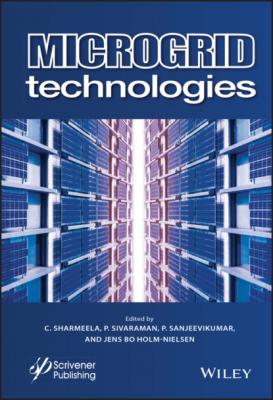Microgrid Technologies. Группа авторов
Чтение книги онлайн.
Читать онлайн книгу Microgrid Technologies - Группа авторов страница 14
 of Energy Technology
of Energy TechnologyAalborg University, Denmark
Acknowledgements
Foremost, thanks to the Almighty for his everlasting love throughout this endeavor.
The Acknowledgements section is always a place to appreciate the dedication, commitment, resources, and timely solution either with the digital platform or a real-time medium; timely support and bond of encouragement are vital tools for teachers and researchers from their Institution.
In these regards, we, editors, express our sincere thanks to Mr. S. Rajkumar, Executive, JLL, Bengaluru, India; Ms. A. Thaiyal Nayagi, Lecturer, Rane Polytechnic College, Trichy, India; Mr. S. Muthukumaran, Director, TECH Engineering Services, Chennai, India; Mr. K. Balaji, Sr. Electrical Engineer, Sree Nandees Technologies, Chennai, India; Mr. K. Sasikumar, Electrical Engineer, Mott MacDonald, Noida, India; Center for Bioenergy and Green Engineering, Department of Energy Technology, Aalborg University, Esbjerg, Denmark, and Department of Electrical and Electronics Engineering, College of Engineering Guindy, Anna University, Chennai, India.
We, editors, got the full support and executed the task promptly where our Institution devoted the time and liberty for enhancement with research in particular to make this book a great success.
I wish one and all who devoted time and effort for the grand success with the book.
Warm regards, Editors
1
A Comprehensive Review on Energy Management in Micro-Grid System
Sanjay Kumar1*, R. K. Saket2, P. Sanjeevikumar3 and Jens Bo Holm-Nielsen3
1Electrical & Electronics Engineering Department, Centurion University of Technology and Management, Odisha, India
2Electrical Engineering Department, IIT (BHU) Varanasi, India
3Center for Bioenergy and Green Engineering, Department of Energy Technology, Aalborg University, Esbjerg, Denmark
Abstract
Since the last decades there has been a huge exploitation of non-conventional (renewable) energy resources which has increased significantly. A Micro-Grid (MG) presents an appropriate concept to integrate local resources of renewable energy with Storage System of Energy (SSE) and are synchronized to supply the customers’ requirement in different circumstances. Apart from this, the Management System of Energy (MSE) has been analyzed for allocating the output power from the Distributed Generator (DG) units optimally. It also satisfies the local demand, regulates the voltage and frequency of the smart MG, and secures a flat switching between modes, connected to grid and mode of islanded operation. In this article the authors have made an outmost effort about the area of MG–MSE, evolved in the current framework, discussing the storage units and generation of MG, the importance of Electric Vehicles (EVs) as a backup unit, combined heat and power for supplying the thermal requirements, objectives function of MG-MSE and constraints of the systems and current algorithms of optimization.
Keywords: Management System of Energy (MSE), Micro-Grid (MG), Electric Vehicles (EVs), Heat and Power Combination (HPC), optimization algorithms
1.1 Introduction
Previously, fossil fuel represents the popular source of electricity, creating emissions of gaseous pollutant in our environment. This led to the advent of renewable energy sources, which provided clean energy and have become the most suitable choice for mitigating the dependency on fossil fuel as it also decreases the Greenhouse effect from the atmosphere. The other natural resources included solar, wind, ocean, biomass, hydro, and geothermal, etc. and were capable of producing electrical energy.
As per the renewable global status report of 2017, the power sector is mainly concerned about the renewable technologies policy, which gives a facility of integration of it into the existing energy systems. Figure 1.1 shows the universal electricity creation until the end of 2016, and also shows that about 30.28% of the entire power is depicted by means of the renewable sources. The estimation is about 2,017 GW out of 6,660 GW the total global electrical energy capacity. Hydropower takes the 1st position in the production of RE.
Clearly, it is shown in Figure 1.2 that about 16.46% of the total power is supplied by the hydropower. It is 54.34% of the RE. The wind power follows it, which is about 7.3% of the total and 24.15% of renewable sources. Then comes Photovoltaic (PV) power (15.02% of RE), about 4.55% of total power capacity, bio-power (5.55% of RE) is about 1.7%, and others are 0.9%. But in 2016, the newly implemented renewable energy is increased by solar (PV) power (47%), wind power (15.5%) and hydropower (9) compared to 2015 [1].
Figure 1.3 shows the consumption of energy sources like natural gas, coal, renewable sources, nuclear, petroleum and other liquid fuels from the year 1090 to 2040 [2]. According to this, consumption of renewable sources is going to increase by 30% in the duration from 2015 to 2040.
Figure 1.1 The renewable global status report.
Figure 1.2 Consumption of renewable energy sources.
Figure 1.3 Intensification of various energy sources from 1990 to 2040.
Nowadays, maximum research is going on the utility of renewable energy. Micro-grid integration has taken the maximum concentration of researchers. A micro-grid (MG) is a distributed network that includes different possible distributed resources of energy, which can be considered as a single system, that can be optimizable, means can be balanced with generations and loads with a suitable storage system. It is also capable of doing work independently with or without connection with the utility power grid [3].
A micro-grid is a network or an association of local electrical generation resources connected through a common point known as PCC. The micro-grid has one or more renewable generation units, conventional power generation system, the electrical storage system (ESS), the thermal storage system (TSS), electrical loads, and thermal loads. The conventional power generation system can consist of the micro turbine (MT), diesel generator set, etc. Similarly, in renewable generation units, we can make a photovoltaic (PV) generation system, wind turbines, biomass and hydrokinetic